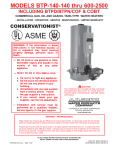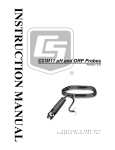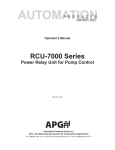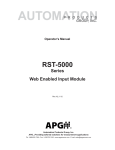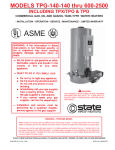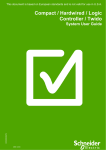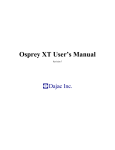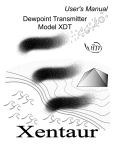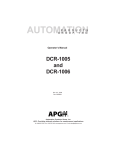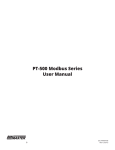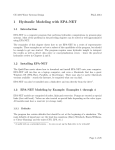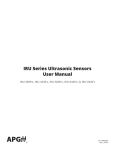Download User Manual - Automation Products Group, Inc.
Transcript
LOE Ultrasonic Level Sensors User Manual Web Enabled Controller APG R Doc #9004258 Rev B, 09/15 Table of Contents Introduction................................................................................................................. iii Warranty and Warranty Restrictions..................................................................... iv Chapter 1: Specifications and Options..................................................................... 1 Dimensions.........................................................................................................................................1 Specifications................................................................................................................................ 2-3 Model Number Configurator........................................................................................................... 3 System Wiring Diagrams............................................................................................................ 4-6 Chapter 2: Installation and Removal Procedures and Notes...............................7 Tools Needed...................................................................................................................................... 7 Connection Notes.............................................................................................................................. 7 Electrical Installation...................................................................................................................... 7 Installation Notes............................................................................................................................. 8 Mounting Instructions.................................................................................................................... 8 Software Setup.............................................................................................................................9-13 Removal Instructions.................................................................................................................... 13 Chapter 3: Programming with Modbus TCP/IP.................................................... 14 Modbus Polling via Ethernet with Modbus TCP/IP............................................................ 14-15 LOE Generic Modbus Register List..............................................................................................15 Modbus Programming of Individual Sensors........................................................................... 16 Chapter 4: LOE Embedded Web Server................................................................... 16 Accessing the LOE Embedded Web Server .............................................................................. 16 Navigating the LOE Embedded Web Server......................................................................... 16-17 LOE Sensor Input Configuration Submenus........................................................................ 18-31 Modbus Sensor Configuration Registers............................................................................. 32-34 LOE Utility Menus.................................................................................................................... 35-38 Chapter 5: Maintenance............................................................................................39 General Care..................................................................................................................................... 39 Troubleshooting.............................................................................................................................. 39 Calibration........................................................................................................................................40 Repair and Returns.........................................................................................................................40 ii Tel: 1/888/525-7300 • Fax: 1/435/753-7490 • www.apgsensors.com • [email protected] Introduction Thank you for purchasing an LOE Ultrasonic Level Sensor and Web Enabled Controller from APG. We appreciate your business! Please take a few minutes to familiarize yourself with your LOE and this manual. The LOE Ultrasonic Level Sensor and Web Enabled Controller offers a wide degree of integrated, flexible, remote and local control and monitoring for your system. The LOE can control up to 10 APG Modbus sensors--any combination of level, pressure, magnetostrictive and ultrasonic--and two output relay terminals. All readings are available for control and monitoring via TCP/IP for local or remote network access. The LOE also had flexible power options: it can use either POE or an independent 12-28 VDC power source. Reading your label Every APG controller comes with a label that includes the controller’s model number, part number, and serial number. The LOE label also indicates the default IP address, subnet mask, and mac address. Please ensure that the model number on your label matches your order. Tel: 1/888/525-7300 • Fax: 1/435/753-7490 • www.apgsensors.com • [email protected] iii Warranty and Warranty Restrictions APG warrants its products to be free from defects of material and workmanship and will, without charge, replace or repair any equipment found defective upon inspection at its factory, provided the equipment has been returned, transportation prepaid, within 24 months from date of shipment from factory. THE FOREGOING WARRANTY IS IN LIEU OF AND EXCLUDES ALL OTHER WARRANTIES NOT EXPRESSLY SET FORTH HEREIN, WHETHER EXPRESSED OR IMPLIED BY OPERATION OF LAW OR OTHERWISE INCLUDING BUT NOT LIMITED TO ANY IMPLIED WARRANTIES OF MERCHANTABILITY OR FITNESS FOR A PARTICULAR PURPOSE. No representation or warranty, express or implied, made by any sales representative, distributor, or other agent or representative of APG which is not specifically set forth herein shall be binding upon APG. APG shall not be liable for any incidental or consequential damages, losses or expenses directly or indirectly arising from the sale, handling, improper application or use of the goods or from any other cause relating thereto and APG’s liability hereunder, in any case, is expressly limited to the repair or replacement (at APG’s option) of goods. Warranty is specifically at the factory. Any on site service will be provided at the sole expense of the Purchaser at standard field service rates. All associated equipment must be protected by properly rated electronic/electrical protection devices. APG shall not be liable for any damage due to improper engineering or installation by the Purchaser or third parties. Proper installation, operation and maintenance of the product becomes the responsibility of the user upon receipt of the product. Returns and allowances must be authorized by APG in advance. APG will assign a Return Material Authorization (RMA) number which must appear on all related papers and the outside of the shipping carton. All returns are subject to the final review by APG. Returns are subject to restocking charges as determined by APG’s “Credit Return Policy”. iv Tel: 1/888/525-7300 • Fax: 1/435/753-7490 • www.apgsensors.com • [email protected] Chapter 1: Specifications and Options • Dimensions LOE-2126, LOE-6126 6.05” 153.7mm 4.00” 101.6mm 2.40” 61.0mm 2” NPT 2.30” 58.4mm 5.50” 139.7mm 2.00” 50.8mm 4.00” 101.6mm LOE-3136 6.05” 153.7mm 2.40” 61.0mm 3” NPT 3.86” 98.0mm 3.00” 76.2mm Tel: 1/888/525-7300 • Fax: 1/435/753-7490 • www.apgsensors.com • [email protected] 5.50” 139.7mm 1 • Specifications Performance Operating Range Beam Pattern Transducer Frequency Response Time 0.6 - 15.0 ft. / 7 in. - 180 in. / 178mm - 4572mm (6126) 1.0 - 25.0 ft. / 12 in. - 300 in. / 305mm - 7620mm (2126) 1.5 ft. - 40 ft. / 18 in. - 480 in. / 458mm - 12192mm (3136) 9° off axis 43 kHz (3136) / 69 kHz (2126, 6126) Programmable, 5 Hz maximum (200 ms) Communications Digital Output Ethernet TCP/IP Modbus Ethernet TCP/IP via embedded webserver (LAN only) Ethernet TCP/IP to APG-provided website 2 Isolated Solid State Relays Inputs RS-485 Modbus (up to 10 slave sensors) Electrical Operational Supply Voltage (at sensor) Current Draw Power Rating 48 VDC via POE (requires injector or switch) 12-28 VDC 40 mA @ 48 VDC 80 mA @ 24 VDC 130 mA Max (Isolated SSRs) 2.0 W Max Accuracy Accuracy Resolution ±0.25% of detected range 0.1 inch (2.54 mm) Environmental Operating Temperature -40 to 60°C (-40 to 140°F) Internal Temperature Compensation Yes Enclosure ProtectionIP65 Materials of Construction Transducer Housing PVDF Upper HousingPC/PET Transducer Type Ceramic, PVDF faced 2 Tel: 1/888/525-7300 • Fax: 1/435/753-7490 • www.apgsensors.com • [email protected] Mounting LOE-2126 LOE-3136 LOE-6126 2” Ø NPT 3” Ø NPT 2” Ø NPT Compatible APG Modbus Senors UltrasonicMNU Magnetostrictive MPX-E1, MPX-R1 Pressure PT-400-L5, PT-400-L31, PT-500-L5, PT-500-L31 Controllers DCR-1006A, MND • Model Number Configurator Part Number: LOE - _____ A A. Model □ 2126 □ 3136 □ 6126 1 - 25 ft. (305mm - 7620mm); 69 kHz; 2” NPT threads 1.5 - 40 ft. (458mm - 12192mm); 43 kHz; 3” NPT threads 0.6 - 15 ft. (178mm - 4572mm); 69 kHz; 2” NPT threads Tel: 1/888/525-7300 • Fax: 1/435/753-7490 • www.apgsensors.com • [email protected] 3 • System Wiring Diagrams External 12-28 VDC Source Wiring To 12-28 VDC Power Supply - + COM OK SEND/ RESET 24V ETHERNET PORT TR1 24V TR1 TR2 B A RS-485 TR2 B A RS-485 NOTE: Power terminals for 24V and GND can only be used to power Modbus sensors if LOE is powered via POE. If LOE is powered via 12-28 VDC supply, Modbus sensors must be powered independently. GND POE (Power over Ethernet) Wiring To Network Connection LAN LAN + DC POWER POE Power Injector 24V To AC power 4 B A RS-485 GND GND Terminal inside housing supplies 24 Vdc to power attached Modbus devices when powering the LOE from a POE source. Tel: 1/888/525-7300 • Fax: 1/435/753-7490 • www.apgsensors.com • [email protected] Modbus Sensor Daisy-chain Wiring 270 Ω terminating resistor NOT internal to LOE GND TR2 RS-485 A B TR2 TR1 24V NOTE: Power terminals for 24V and GND can only be used to power Modbus sensors if LOE is powered via POE. If LOE is powered via 12-28 VDC supply, Modbus sensors must be powered independently. TR1 Note: Terminating resistor size recommended based on input resistance of LOE. Length of cable and overall impedence of network may necessitate a different size resistor. Use shielded cable Trunk Line Sensor Line Drops Tel: 1/888/525-7300 • Fax: 1/435/753-7490 • www.apgsensors.com • [email protected] V+ B A GND Sensor 2 V+ B A GND Sensor 1 V+ GND B A 270 Ω terminating resistor at last sensor Sensor 3 5 System Overview - LOE with Modbus network, SSR’s and Internet Connection Computer on Internet Server Hosting Website and Logged Data Computer on Local Network Network / Internet Connection Connection to Internet Solid State Relays Modbus Input MNU Ultrasonic Sensors 6 MP Magnetostrictive Float Level Sensors Tel: 1/888/525-7300 • Fax: 1/435/753-7490 • www.apgsensors.com • [email protected] Chapter 2: Installation and Removal Procedures and Notes • Tools Needed • Flat head screwdriver to remove knockouts for cables. • If you are using a stand pipe to mount your LOE, you will probably need tools to install the stand pipe. • For any attached Modbus sensors, please consult each sensor’s user manual for installation notes and instructions. NOTE: For any APG sensor user manual, please visit http://apgsensors.com/support. • Connection Notes • Up to 10 Modbus sensors can be connected to the LOE in any combination. • SSR’s are rated for 400V, 130mA max. IMPORTANT: Each Modbus sensor must be connected to the network individually and assigned a unique Sensor Number before the next sensor can be added. • Electrical Installation • • • • • • Use flat head screwdriver to remove knockouts on either side of LOE housing. Insert included cable fittings in knockout holes. Connect any output relays first. Connect LOE to Ethernet/network. Connect independent 12-28 VDC supply if not using POE. Connect and set up one Modbus sensor at a time. IMPORTANT: Multiple Modbus sensors added to the network simultaneously are all assigned the same Modbus address/sensor number: 1. Sensors MUST be added to the network individually. Tel: 1/888/525-7300 • Fax: 1/435/753-7490 • www.apgsensors.com • [email protected] 7 • Installation Notes • Mount your LOE sensor so that it has a clear, perpendicular sound path to the surface being monitored. Your sensor should be mounted away from tank or vessel walls and inlets. (See Figure 2.1) • The sound path should be free from obstructions and as open as possible for the 9° off axis beam pattern. • If you are using a stand pipe, please see our guide to stand pipes on our website: http://www.apgsensors.com/about-us/blog/how-to-install-a-stand-pipe. Figure 2.1 • Mounting Instructions Mounting your LOE is easy if you follow a few simple steps: • Never over-tighten the sensor. • Always screw in your sensor by hand to avoid cross-threading. Thread failure can be a problem if you damage threads by over-tightening them or by crossing threads. IMPORTANT: Do not over tighten! The sensor should be threaded in only hand tight. NOTE: Do not mount the sensor where the beam will intersect objects such as fill streams, pipes, ladder rungs, wall seams, or corrugated tank walls. 8 Tel: 1/888/525-7300 • Fax: 1/435/753-7490 • www.apgsensors.com • [email protected] • Software Setup Initial setup of the LOE and individual Modbus sensors is done via an embedded web server. The embedded server can be accessed by using either the serial number or local IP address of the LOE and a web browser (Internet Explorer, Chrome, Firefox, etc). NOTE: Port 6700 must be open on your local network for the LOE to connect. Accessing LOE Embedded Web Server via Serial Number The easier way to access the embedded web server is to type loe_xxx into a web browser on a computer connected to the same local network as the LOE. xxx represents the numeric portion of the LOE’s serial number. See Figures 2.2 and 2.3. Figure 2.2 Figure 2.3 NOTE: If your web browser performs a web search for “loe_xxx” istead of accessing the server, type “http://loe_xxx”. Some networks will block this direct access to the LOE. If this is the case, you will need to use the IP address of your LOE to access the embedded web server. The IP address can be obtained two ways: ask your local network administrator, or logon to your APG-provided website, www.levelandflow.com. Tel: 1/888/525-7300 • Fax: 1/435/753-7490 • www.apgsensors.com • [email protected] 9 Accessing LOE Embedded Web Server via Local IP Address Log on to your APG-provided website, and a list of sites will be displayed on your screen (see Figure 2.4). Select the site where the new LOE is installed. From the list of sensors at thie site, select the sensor with the serial number that matches the new LOE. (See Figure 2.5) Figure 2.4 Figure 2.5 10 Tel: 1/888/525-7300 • Fax: 1/435/753-7490 • www.apgsensors.com • [email protected] On the Sensor Information screen you will see the IP Address of the newly installed LOE. (See Figure 2.6.) Type the LOE’s IP address into your browser’s address bar (See Figure 2.7). Figure 2.7 Figure 2.6 NOTE: For further information on using your APG-provided remote website, please visit www.apgsensors.com/support for a user manual, or contact us at 1-888-525-7300. Logging on to the LOE Embedded Web Server The LOE’s embedded webpage should now be open, showing the Main Display page (See Figure 2.8). This page lists the LOE, any Modbus sensors attached to the LOE, and displays each sensor’s current reading. The LOE is displayed as sensor #11. The configured sensor number for each Modbus sensor will show as its Sensor Number. Every new Modbus sensor defaults to sensor number 1. Figure 2.8 IMPORTANT: Multiple Modbus sensors added to the network simultaneously are all assigned the same sensor number: 1. Sensors must be added to the network individually. Tel: 1/888/525-7300 • Fax: 1/435/753-7490 • www.apgsensors.com • [email protected] 11 Click on Home to bring up the Menu page (See Figure 2.9). The first menu link clicked during each session will prompt a User Name and Password login for the LOE (See Figure 2.10). The default User Name is admin, and the default Password is password. Figure 2.9 Figure 2.10 NOTE: See the Security Setting Menu (Page 37) to change this user name and password. Assigning Modbus Senor Numbers Click on RS-485 Network Settings to bring up the RS485 Settings page (See Figure 2.11). See section RS-485 Network Settings for a full descrition of each parameter in this menu (Page 38). Figure 2.11 12 Tel: 1/888/525-7300 • Fax: 1/435/753-7490 • www.apgsensors.com • [email protected] Change Numb of Sensors On Line to reflect the total number of Modbus sensors you will be connecting to your LOE. Click Change to send the new value to the LOE. With Sensor Number to View set to 1 (for the latest sensor added to the Modbus network), set New Sensor Number to the highest available number. Click Change to send the new value to the LOE. Repeat this process for each Modbus sensor as it is added to the network. NOTE: If you control the power to each Modbus sensor seperately, powering up a new sensor after assigning a Modbus address to the previous sensor will allow you to assign an address to the new sensor without leaving the RS845 Settings Menu. IMPORTANT: None of parameters in the RS485 Settings menu automatically update. Each one must be manually configured. • Removal Instructions • • • • Disconnect power to the LOE first. Disconnect network connection. Disconnect any sensors, relays, and switched inputs. Remove the LOE and store it in a dry place, at a temperature between -40° F and 180° F. Tel: 1/888/525-7300 • Fax: 1/435/753-7490 • www.apgsensors.com • [email protected] 13 Chapter 3: Programming with Modbus TCP/IP • Modbus Polling via Ethernet with Modbus TCP/IP Using the LOE’s IP address, and port number 502, readings can be polled from the LOE for any attached sensors via RS-485 Modbus commands. Up to 14 16-bit Input Registers, beginning with register 299, can be polled with a single command. Below is a sample Modbus command illustrating the necessary syntax. Example: 00 01: Transaction Identifier 00 00: Protocol Identifier 00 06: Message Length (6 bytes to follow) 0B : The Reporting Unit Identifier [sensor number] (0B hex = 11) 04: The Function Code (04 = read Input Registers) 01 2E: The Data Address of the first register requested. (12E hex + 1 = 303) 00 02: The total number of registers requested. (read 2 registers, i.e. 303 to 304) Byte order (hex values) 00 01 00 00 00 06 0B 04 01 2E 00 02 Notes: • Reporting Unit indicates the sensor reading being polled from the LOE, in hex. 01 - 0A are for Modbus sensors 1 - 10 attached to the LOE. 0B (i.e. sensor 11) reads the values from the LOE sensor (See Figure 2.8). Unused registers (i.e., those not associated to an attached sensor) will return zeros when polled. • Function Code 04 reads the Input Registers. No other functionality (e.g., polling from or writing to Holding Registers) is supported via Modbus TCP/IP with the LOE. Complete control functionality is available through the embedded web server and through your APG-provided website (www.levelandflow.com). • Data Address of registers, decimal to “hex minus 1” conversion: Decimal Address Hex minus 1 Decimal Address Hex minus 1 299 12A 306 131 300 12B 307 132 301 12C 308 133 302 12D 309 134 303 12E 310 135 304 12F 311 136 305 130 312 137 14 Tel: 1/888/525-7300 • Fax: 1/435/753-7490 • www.apgsensors.com • [email protected] • Total number of registers requested, up to 14, given in hex: # of Registers Hex equivalent # of Registers Hex equivalent 01 01 08 08 02 02 09 09 03 03 10 0A 04 04 11 0B 05 05 12 0C 06 06 13 0D 07 07 14 0E • LOE Generic Modbus Register List Input Registers (0x04) Register 30299 30300 30301 30302 30303-30304 30305-30306 30307 (upper bits) 30307 (lower bits) 30308 30309 (upper bits) 30309 (lower bits) 30310 (upper bits) 30310 (lower bits) 30311 (upper bits) 30311 (lower bits) 30312 (upper bits) 30312 (lower bits) Returned Data Sensor Type Distance/Level 1, Top (in mm, unsigned) Distance/Level 2, Bottom (in mm, unsigned) Sensor Temperature Reading (in 0C, signed) Calculated 1 (raw) Calculated 2 (raw) Version Signal Strength Battery Voltage Sensor Trip 1 Alarm Sensor Trip 1 Status Sensor Trip 2 Alarm Sensor Trip 2 Status Sensor Trip 3 Alarm Sensor Trip 3 Status Sensor Trip 4 Alarm Sensor Trip 4 Status This is the list of generic Input Registers for polling the LOE and any connected sensors. Actual registers used vary by sensor. Please see the user manual for each sensor for a full and accurate list of registers. NOTE: For more information about Modbus RTU, please visit www.modbus.org. Tel: 1/888/525-7300 • Fax: 1/435/753-7490 • www.apgsensors.com • [email protected] 15 • Modbus Programming of Individual Sensors The LOE does NOT support full Modbus programming of attached sensors. Full control and configuration of individual sensors is supported through the LOE’s embedded web server and through your APG-provided webpage, www.levelandflow.com. NOTE: For any APG sensor user manual, please visit http://apgsensors.com/support. Chapter 4: LOE Embedded Web Server • Accessing the LOE Embedded Web Server See the Software Setup section of chapter 2 (pages 9 - 11) for instructions for accessing and signing into the LOE embedded web server. • Navigating the LOE Embedded Web Server The LOE embedded web server has two primary screens--the Main Display Page (Figure 4.1) and Menu Page (Figure 4.2)--and a screen for each of 9 submenus. The submenus can be understood in three groups: • LOE Sensor Input Configuration Submenus Basic Parameters Application Settings • Modbus Sensor Configuration Registers RS-485 Modbus Input Reg RS-485 Modbus Holding 1 RS-485 Modbus Holding 2 • LOE Utility Menus Network Security Label RS-485 Network Settings The Menu Page also has a link back to the Main Display Page. 16 Tel: 1/888/525-7300 • Fax: 1/435/753-7490 • www.apgsensors.com • [email protected] Figure 4.1 Figure 4.2 Tel: 1/888/525-7300 • Fax: 1/435/753-7490 • www.apgsensors.com • [email protected] 17 • LOE Sensor Configuration Submenus LOE Application Settings Figure 4.3 The Application Parameters menu configures the application-specific parameters applied to the calculated reading from the LOE sensor. PARAMETER Full Distance RANGE 0 - Sensor Maximum Full Distance sets the distance from the LOE sensor Zero Point (See Figures 4.5 - 4.7) to the full level of the vessel being monitored. Not used when Application Type is set to 0 (Value). PARAMETER Empty Distance RANGE 0 - Sensor Maximum Empty Distance sets the distance from the LOE sensor Zero Point (See Figure 4.5 - 4.7) to the empty level of the vessel being monitored. Not used when Application Type is set to 0 (Value). 18 Tel: 1/888/525-7300 • Fax: 1/435/753-7490 • www.apgsensors.com • [email protected] PARAMETER Application Type RANGE 0 = Value (Distance) 1 = Level 2 = Volume of Standing Cylindrical Tank with or without Hemispherical Bottom 3 = Volume of Standing Cylindrical Tank with or without Conical Bottom 4 = Volume of Standing Rectangular Tank with or without Chute Bottom 5 = Volume of Horizontal Cylindrical Tank with or without Spherical Ends 6 = Volume of Spherical Tank 7 = Pounds (Linear Scaling) 8 = User Defined Units 9 = Volume of Vertical Oval Tank 10 = Volume of Horizontal Oval Tank Application Type is used to choose the parameter configuration to convert the distance of Distance into the configured reading on the Main Display Page (See Figure 4.1). After selecting an Application Type and pressing “Change,” the Application Parameters menu updates to reflect the parameters of the chosen application. See Tank Parameters for an explaination of each Application Type and its associated parameters. PARAMETER Volume Units RANGE 1 = Feet3 2 = Million Feet3 3 = Gallons 4 = Meters3 5 = Liters 6 = Inches3 7 = Barrels Volume Units selects the units of measure for the configured reading on the Main Display Page (See Figure 4.1) when a volumetric application is selected. The settings is not used when the Application Type is set to 0, 1, 7, or 8. PARAMETER Units RANGE 1 - feet 2 - inches 3 - meters Units is used to select the units of measurement for distance or level applications. The units will also determine the resolution of Basic and Application Parameters. The resolution is: feet 0.01, inches 0.1, and meters 0.001. Tel: 1/888/525-7300 • Fax: 1/435/753-7490 • www.apgsensors.com • [email protected] 19 Tank Parameters Application Type Tank Parameter Function 0 - Distance Parameter 1 Not Used Parameter 2 Not Used Parameter 3 Not Used Parameter 4 Not Used Parameter 5Not Used Distance (factory default) measures the distance from the Zero Point of the LOE sensor to the target surface. Distance Application Type Tank Parameter Function 1 - Level Parameter 1 Not Used Parameter 2 Not Used Parameter 3 Not Used Parameter 4 Not Used Parameter 5Not Used Level Level calculates the depth or level of the vessel being monitored, based on the Full Distance and Empty Distance. Application Type Tank Parameter Function 2 - Standing Cylindrical Parameter 1 Tank Diameter Tank with Parameter 2 Bottom Radius Hemispherical Parameter 3 Not Used Bottom Parameter 4 Not Used Parameter 5Not Used Diameter Full Distance Empty Distance or 20 Tel: 1/888/525-7300 • Fax: 1/435/753-7490 • www.apgsensors.com • [email protected] Bottom Radius Application Type Tank Parameter Function 3 - Standing Cylindrical Parameter 1 Tank Diameter Tank with Parameter 2 Bottom Radius Conical Parameter 3 Cone Length (Height) Bottom Parameter 4 Not Used Parameter 5Not Used Diameter Full Distance Empty Distance Cone Length Cone Diameter Application Type 4 - Standing Rectangular Tank with Chute Tank Parameter Parameter 1 Parameter 2 Parameter 3 Parameter 4 Parameter 5 Function Tank X Dimension Tank Y Dimension Chute X Dimension Chute Y Dimension Chute Length (Height) Full Distance Empty Distance Tank X Tank Y or Chute Length Chute Y Chute X Application Type Tank Parameter Function 5 - Horizontal Cylindrical Parameter 1 Tank Length Tank with Parameter 2 Tank Diameter Spherical Ends Parameter 3 Radius of Ends Parameter 4 Not Used Parameter 5Not Used Full Distance Diameter Empty Distance End Radius Length Tel: 1/888/525-7300 • Fax: 1/435/753-7490 • www.apgsensors.com • [email protected] 21 Application Type Tank Parameter Function 6 - Spherical Tank Parameter 1 Tank Diameter Parameter 2 Not Used Parameter 3 Not Used Parameter 4 Not Used Parameter 5Not Used Empty Distance Application Type Tank Parameter Function 7 - Pounds Parameter 1 Multiplier (Linear Scaling) Parameter 2 Unit Definition (label) Parameter 3 Not Used Parameter 4 Not Used Parameter 5Not Used Pounds allows for a multiplier (Parameter 1) to be applied to the calculated level measurement, creating a linear scalar as the output to configured reading on the Main Display Page. Such a multplier could convert the distance or level measurement of a tank with simple geometry into a measurement of weight. Application Type Tank Parameter Function 8 - User Defined Units Parameter 1 Not Used Parameter 2 Not Used Parameter 3 Not Used Parameter 4 Not Used Parameter 5Not Used User Defined Units is not used by the LOE. Application Type 8 can be selected, but after leaving the Application Parameters Menu, Application Type reverts to 0. 22 Tel: 1/888/525-7300 • Fax: 1/435/753-7490 • www.apgsensors.com • [email protected] Full Distance Diameter Application Type Tank Parameter Function 9 - Vertical Oval Parameter 1 Tank Length Tank Parameter 2 Tank Depth Parameter 3 Tank Width Parameter 4 Not Used Parameter 5Not Used Full Distance Empty Distance Depth Width Length Application Type Tank Parameter Function 10 - Horizontal Oval Parameter 1 Tank Length Tank Parameter 2 Tank Depth Parameter 3 Tank Width Parameter 4 Not Used Parameter 5Not Used Full Distance Empty Distance Depth Length Width Basic Parameters Figure 4.4 Tel: 1/888/525-7300 • Fax: 1/435/753-7490 • www.apgsensors.com • [email protected] 23 PARAMETERRANGE Sensitivity 0 - 100% Sensitivity sets the level of gain that is applied to the echo. When operating in AutoSense, Hard-Target, or Soft-Target (see Gain Control), Sensitivity sets an upper limit for the amplification that can be applied to the echo. If operating in Manual, this parameter sets the gain. When using manual gain control, set Sensitivity to the minimum value that will allow the target to be reliably tracked through the full range of expected environmental conditions. IMPORTANT: Parameter values stored on the LOE will not update until the “Change” button is clicked. PARAMETER RANGE Blanking Determined by sensor model Blanking sets the blanking distance, which is the zone from the Zero Point of the sensor to the point from which the first echo will be accepted. While blanking distance can be used to ignore unwanted targets--such as welds, seams, pipe fittings, or gaskets--between the sensor and the closest acceptable target level, such objects generally create additional reflections and echoes, which are hard to filter out. More often, blanking distance is used for a sensor installed in a stand pipe. Because of the physical properties of an ultrasonic sensor, objects cannot be detected closer than approximately 1 foot from the face of most transducers (7 inches for LOE-6126). However, this distance varies according to how much energy is being transmitted (Pulses) and the installation. IMPORTANT: Blanking is always measured from the Zero Point of the sensor. See Figures 4.5 - 4.7. 24 Tel: 1/888/525-7300 • Fax: 1/435/753-7490 • www.apgsensors.com • [email protected] Effective Measurement Zone Effective Measurement Zone Offset Zero Point Blanking Offset = 0 Sensor Max. Distance Effective Measurement Zone Offset Zero Point Blanking Offset > 0 Figure 4.5 Sensor Max. Distance Figure 4.6 Zero Point Blanking Offset < 0 Sensor Max. minus Offset Sensor Max. Distance Figure 4.7 PARAMETERRANGE Pulses 0-20 Pulses sets the maximum number of pulses the sensor can transmit when operating in AutoSense, HardTarget, or Soft-Target (see Gain Control), or sets the number of pulses when operating in Manual. The more pulses that are sent in a burst, the stronger the returning echo. When operating in Manual, increase the strength of the transmission by increasing Pulses for detecting soft targets in damping environments. In acoustically active environments or small enclosed areas, decrease Pulses to reduce multiple echoes. PARAMETERRANGE Gain Control 0 = Manual 1 = AutoSense 2 = Hard-Target 3 = Soft-Target Gain Control selects the control mode for the LOE sensor’s gain settings (Sensitivity and Pulses). In AutoSense, the sensor automatically adjusts the sensitivity and pulses for the best quality return signal. Manual, Hard Target, and Soft Target are user controlled scenarios. In Manual, the user is in full control of Sensitivity and Pulses. For Hard and Soft Target, the user sets maximum Sensitivity and Pulses, but the overall gain is either ramped up slowly (Hard Target) or quickly (Soft Target) by the sensor. PARAMETERRANGE Average 1-32 Average sets the number of qualified samples to average for the displayed reading. Qualified samples are placed in a first-in, first-out buffer, the contents of which are averaged for Distance. The larger the number of qualified samples being averaged, the smoother the output reading will be, and the slower the reading will be to react to quick changes. Tel: 1/888/525-7300 • Fax: 1/435/753-7490 • www.apgsensors.com • [email protected] 25 PARAMETERRANGE Window0 - Sensor Maximum Window determines the corresponding physical range for qualified samples, based on the current Distance. Samples beyond the +/- Window range of the current Distance will not qualify unless the average moves. Samples outside the extents of the Window are written to the Out of Range Samples buffer. (See Figure 4.8.) Example: Window = 6 Inches Out of Range Samples = 10 Samples are rejected within this area unless they persist for 10 consecutive samples All samples are accepted within this area 6” Min. Reading Samples are rejected within this area unless they persist for 10 consecutive samples 6” Current value of Distance Max. Reading Figure 4.8 PARAMETERRANGE Out of Range Samples 0-250 Out of Range Samples sets the number of consecutive samples outside the Window necessary to automatically adjust the current Distance and move the Window. PARAMETERRANGE Sample Rate 1 - 5 Hz Sample Rate is the number of sample readings taken by the LOE every second. PARAMETERRANGE Multiplier 0 - 1.999 Multiplier is used to calibrate the LOE sensor for variations in the speed of sound due to variations in atmospheres. The default of 1.000 is used for most applications. PARAMETERRANGE Temp Comp. 0 = Off 1 = On Temperature Compensation activates or deactivates the LOE’s internal temperature compensation circuit. The speed of sound changes with changes in temperature, therefore changes in temperature can affect distance measurements. These effects can be minimized by activating temperature compensation. 26 Tel: 1/888/525-7300 • Fax: 1/435/753-7490 • www.apgsensors.com • [email protected] PARAMETERRANGE Offset -10 ft - + 10ft Offset is used to change the Zero Point of the LOE sensor. The Zero Point of the sensor is the point from which the calculated distance is measured. When the Offset is set to 0, the Zero Point of the sensor is at the face of the transducer (See Figure 4.5). A positive setting will move the Zero Point forward, in front of the sensor face (See Figure 4.6). Setting the Offset to a negative number will move the Zero Point backward, behind the sensor face (See Figure 4.7). In all cases, Blanking is measured from the end of Offset, and the effective measurement zone of the sensor begins at the forward end of Blanking. If Offset is more negative than Blanking is positive, the net difference will be a loss in sensor maximum range (See Figure 4.7). PARAMETERRANGE Max Distance Determined by sensor model Maximum Distance sets the maximum acceptable signal range (up to the physical maximum of the sensor), measured from the Zero Point. Signals beyond the Maximum Distance are ignored. Under Loss of Echo conditions, the Distance reading will display the Maximum Distance. LOE Readings Figure 4.9 Reading TypeRange Distance Determined by model Distance displays the distance from the sensor to the detected target in the units selected in the Units parameter in the Application Parameters Menu (See Figure 4.3). This reading is always Distance, regardless of the Application Type selected in the Application Parameters Menu. Reading TypeRange Signal Strength 0 - 100 Signal Strength displays the strength of the signal being received by the sensor. 0 represents the lowest quality signal, and 100 represents the highest quality. Reading TypeRange Temperature Temperature displays the current temperature of the thermal device in the LOE sensor body. Tel: 1/888/525-7300 • Fax: 1/435/753-7490 • www.apgsensors.com • [email protected] 27 LOE Trip Outputs and Settings Figure 4.10 Figure 4.11 The LOE has 2 output relays that can be configured to turn on or off based on the Distance reading of the sensor. Trip Type Outputs are configured with two independent digits: the first for Alarm Type (Blank, 1, or 2), and the second for Trip Condition (0-5, 7, or 9). PARAMETERRANGE 0 - Sensor Max Distance Trip Distance Trip Distance sets the value of the primary trip position, which is closest to the Zero Point of the sensor. PARAMETERRANGE 0 - Sensor Max Distance Trip Window Trip Window sets the value from the primary trip position to the secondary trip position, which is farther from the sensor’s Zero Point. Alarm Type Blank_ - No Alarm Designates that no alarm is to be activated or deactivated on the remote APG-provided website (i.e., www. levelandflow.com) for the indicated Trip Condition. To initiate only the visual Trip Status indicator (See Figure 4.11) for Trip Condition 3, Trip Type would be set to 3. Alarm Type 1_ - Active Alarm Designates the active trip point as a web alarm condition. To initiate web alarm whenever the Trip Condition 3 is ON, Trip Type would be set to 13. 28 Tel: 1/888/525-7300 • Fax: 1/435/753-7490 • www.apgsensors.com • [email protected] Alarm Type 2_ - Inactive Alarm Designates an inactive trip point as a web alarm condition. To initiate a web alarm whenever the Trip Condition 3 is OFF, Trip Type would be set to 23. Trip Condition 0 - Near Near activates the Trip whenever the Distance is less than the Trip Distance setting. Trip Condition 1 - Exclusive Exclusive activates the Trip whenever the Distance is less than the Trip Distance setting OR greater than the Trip Distance + Trip Window settings. TRIP TYPE 0 NEAR TRIP TYPE 1 EXCLUSIVE TRIP TYPE 2 HYSTERESIS NEAR Trip Condition 3 - Far TRIP WINDOW ON OFF ON OFF ON ON ON OFF OFF TRIP TYPE 3 FAR Trip Condition 2 - Hysteresis Near Hysteresis Near activates the Trip whenever the Distance becomes less than than the Trip Distance setting. The Trip remains activated until the Distance becomes greater than the Trip Distance + Trip Window settings. The Trip then remains off until the Distance becomes less than the Trip Distance setting again. TRIP DISTANCE TRIP TYPE 4 INCLUSIVE TRIP TYPE 5 HYSTERESIS FAR OFF ON OFF ON OFF OFF OFF ON ON Figure 4.12 Far activates the Trip whenever the Distance is greater than the Trip Distance setting. Trip Condition 4 - Inclusive Exclusive activates the Trip whenever the Distance is greater than the Trip Distance setting AND less than the Trip Distance + Trip Window settings. Trip Condition 5 - Hysteresis Far Hysteresis Far activates the Trip whenever the Distance becomes greater than the Trip Distance + Trip Window settings. The Trip remains activated until the Calc. Dist,Level,Volume becomes less than the Trip Value setting. The Trip remains off until the Distance becomes greater than the Trip Distance + Trip Window settings again. Tel: 1/888/525-7300 • Fax: 1/435/753-7490 • www.apgsensors.com • [email protected] 29 Trip Condition 6 - Disable Trip Relay 16 - Turn on Trip Relay 26 - N/A Disable de-activates the Trip or SS Relay output. Trip Condition 7 - Loss of Echo Loss of Echo activates the output when the maximum calculated reading is reached. Trip Condition 8 - Timed Interval Timed Interval activates the output for a set amount of seconds every set amount of minutes (See Figure 4.13). When Trip Type is set to 8, Trip Distance and Trip Window are changed to “Interval Time (minutes)” and “On Time (seconds)”. TRIP TYPE 1 EXCLUSIVE TRIP TYPE 2 HYSTERESIS NEAR Relay “OFF”(open) Relay “ON” (closed) TRIP WINDOW ON OFF ON OFF ON ON ON OFF OFF TRIP TYPE 3 FAR TRIP TYPE 4 INCLUSIVE INTERVAL TIME (in minutes) “ON” TIME (in seconds) TRIP TYPE 0 NEAR TRIP DISTANCE TRIP TYPE 5 HYSTERESIS FAR OFF ON OFF ON OFF OFF OFF ON ON Figure 4.13 Figure 4.12 Trip Condition 9 - Abrupt Change Abrupt Change activates the output whenever a user-defined maximum rate of level change (change in distance or level divided by elapsed time) is exceeded. Trip Distance defines the distance and Trip Window defines the time. 30 Tel: 1/888/525-7300 • Fax: 1/435/753-7490 • www.apgsensors.com • [email protected] External Website Communication Status Figure 4.14 The LOE embedded web server includes one parameter and two status reports for communication with the remote APG-provided website (i.e., www.levelandflow.com). PARAMETERRANGE Retry Time 30 - 180 Seconds Retry Time sets the time delay (in seconds) between attempts by the LOE to contact the external website. DISPLAYRANGE Remote Call in Time 1 - 86400 Seconds Remote Call in Time displays the duration of the last communication between the LOE and the external website. DISPLAYRANGE Remote Bytes 8 or 160 Bytes Remote Bytes displays the number of bytes of data sent in the last communication between the LOE and the external website. 8 bytes indicates a normal, successful transmission. 160 bytes indicates an error occured in the transmission. Tel: 1/888/525-7300 • Fax: 1/435/753-7490 • www.apgsensors.com • [email protected] 31 • Modbus Sensor Configuration Registers RS-485 Modbus Input Registers Figure 4.15 This display-only menu shows the contents of the Input Registers for the selected Modbus sensor (See Figure 2.8). Registers used vary by sensor type. Please see the user manual for each sensor for a full list of registers. • Detected Sensor Type Number and Sensor Model Number List: Sensor Type Model Number Sensor Type Model Number 0 LOE-2126 9 PT-400/PT-500-L31 (Level) 1 LOE-6126 10 PT-400/PT-500-L5 (Pressure) 2 LOE-3136 11 DCR-1006A 3 LOE-7126 12 LPD 4 RST-5001 13 MND 5 MPX-E1/R1 (2 floats) 14 RST-5003/4 6 MPX-E1/R1 (1 float) 15 AUS-7123 7PG-716MTM-1000 8 PG-10 Note: This list represents sensors that interface with various APG Modbus software packages. Not all interface with the LOE. 32 Tel: 1/888/525-7300 • Fax: 1/435/753-7490 • www.apgsensors.com • [email protected] RS-485 Modbus Holding 1 Figure 4.16 This menu shows the contents of the first set of Holding Registers for the selected Modbus sensor (See Figure 2.8). The register names and value restrictions are automatically configured for the type of sensor detected (See Figure 4.15). Because register name and use varies by sensor, including a full breakdown of the registers in this manual would be counterproductive. Please see the user manual for each sensor for a full list of registers. Tel: 1/888/525-7300 • Fax: 1/435/753-7490 • www.apgsensors.com • [email protected] 33 RS-485 Modbus Holding 2 Figure 4.17 This menu shows the contents of the second set of Holding Registers for the selected Modbus sensor (See Figure 2.8). The register names and value restrictions are automatically configured for the type of sensor detected (See Figure 4.15). Because register name and use varies by sensor, including a full breakdown of the registers in this manual would be counterproductive. Please see the user manual for each sensor for a full list of registers. 34 Tel: 1/888/525-7300 • Fax: 1/435/753-7490 • www.apgsensors.com • [email protected] • LOE Utilty Menus Network Settings Figure 4.18 The Network Settings are provided for advanced users only and should not normally require changes. Each LOE ships with the DHCP enabled, which means it will automatically connect to the the APG-provided remote website (usually www.levelandflow.com) and configure its own Network Settings when plugged into a port providing direct internet access. Tel: 1/888/525-7300 • Fax: 1/435/753-7490 • www.apgsensors.com • [email protected] 35 Security Settings Figure 4.19 The Security Settings allow users to set their own user name and password for logging into the embedded webpage. Labels Figure 4.20 The Labels menu allow users to create custom labels for the Main Menu, the LOE, and the sensors attached to the LOE. The “Analog Input Description” is for the LOE itself. 36 Tel: 1/888/525-7300 • Fax: 1/435/753-7490 • www.apgsensors.com • [email protected] Figure 4.21 When labels are created in the Labels menu, they will be reflected on the Main Menu page (See Figure 4.21). RS-485 Network Settings Figure 4.22 Tel: 1/888/525-7300 • Fax: 1/435/753-7490 • www.apgsensors.com • [email protected] 37 The RS-485 (Modbus) Settings menu controls the settings for the Modbus sensors (up to 10) attached to the LOE. PARAMETER Baud Rate Checkboxes RANGE 2400 Baud 9600 Baud Baud Rate Checkboxes are used to select the baud rate of the of the sensors connected to the LOE. All APG Modbus sensors communicate at 9600 Baud. PARAMETER Numb of Sensors On Line RANGE 0 - 10 Numb of Sensors On Line sets the number Modbus sensors connected to the LOE. This setting is not automatically populated or updated. The user must change the setting manually. Numb of Sensors On Line must always be equal or greater than the number of actual sensors attached to the LOE. NOTE: For best results, set Numb of Sensors On Line to the highest number of number of sensor TO BE connected. No further adjustments will be needed as those sensors are connected to the LOE. PARAMETER Sensor Number to View RANGE 1 - 10 Sensor Number to View selects number of the sensor for the LOE to poll for populating the Main Menu and for editing parameters in the Modbus Holding Register menus. PARAMETER New Sensor Number RANGE 0 = No Change 1 - 10 New Sensor Number changes the sensor number assigned to the sensor selected by Sensor Number to View. IMPORTANT: When “Change” is pressed to assign a new sensor number, Sensor Number to View DOES NOT update. PARAMETER RS485 Sample Rate RANGE 1 - 60 Seconds RS485 Sample Rate determines how often the LOE polls the selected Modbus sensor. 38 Tel: 1/888/525-7300 • Fax: 1/435/753-7490 • www.apgsensors.com • [email protected] Chapter 5: Maintenance • General Care Your LOE series controller is very low maintenance and will need little care as long as it is installed correctly. However, in general, you should: • Avoid applications for which the sensor was not designed, such as extreme temperatures, contact with incompatible corrosive chemicals and fumes, or other damaging environments. • Inspect the threads whenever you remove the sensor from duty or change its location. • Troubleshooting Should you have problems with your LOE, here are some troubleshooting steps. • Check the received signal strength (See Figure 4.9). If the signal strength is low, alternately increase Pulses and Sensitivity (See Figure 4.4) until the signal strength improves. • Ensure Temperature Compensation (See Figure 4.4) is On (set to 1). • Set the Gain Control to AutoSense (See Figure 4.4). • Ensure that Blanking (See Figure 4.4) is accurately set to account for any unwanted targets between the sensor and the closest acceptable target (See Figures 4.5 - 4.7). Tel: 1/888/525-7300 • Fax: 1/435/753-7490 • www.apgsensors.com • [email protected] 39 • Calibration This procedure uses targets at known distances to calibrate the LOE sensor’s accuracy. A wall or other large, flat object is recommended for the long range target. • Point the sensor at a target at a known distance near the maximum range of the sensor (See Figure 5.1). • Adjust the Multiplier value until the distance reading on the sensor matches the actual measured distance to the target (See Figure 4.4). • Point the sensor at a target near the minimum measurement range, 1’ plus any Blanking distance (See Figure 5.2). • Adjust the Offset value until the distance reading on the sensor matches the actual measured distance to the target (See Figure 4.4). • Repeat previous two steps until no further adjustment is required. measure measure Figure 5.1 Figure 5.2 • Repair and Returns Should your LOE require service, please contact the factory via phone, email, or online chat. We will issue you a Return Material Authorization (RMA) number with instructions. • Phone: 888-525-7300 • Email: [email protected] • Online chat at www.apgsensors.com Please have your LOE’s part number and serial number available. See Warranty and Warranty Restrictions for more information. 40 Tel: 1/888/525-7300 • Fax: 1/435/753-7490 • www.apgsensors.com • [email protected] Tel: 1/888/525-7300 • Fax: 1/435/753-7490 • www.apgsensors.com • [email protected] 41 APG R Automation Products Group, Inc. Tel: 1/888/525-7300 • Fax: 1/435/753-7490 • www.apgsensors.com • [email protected]
















































